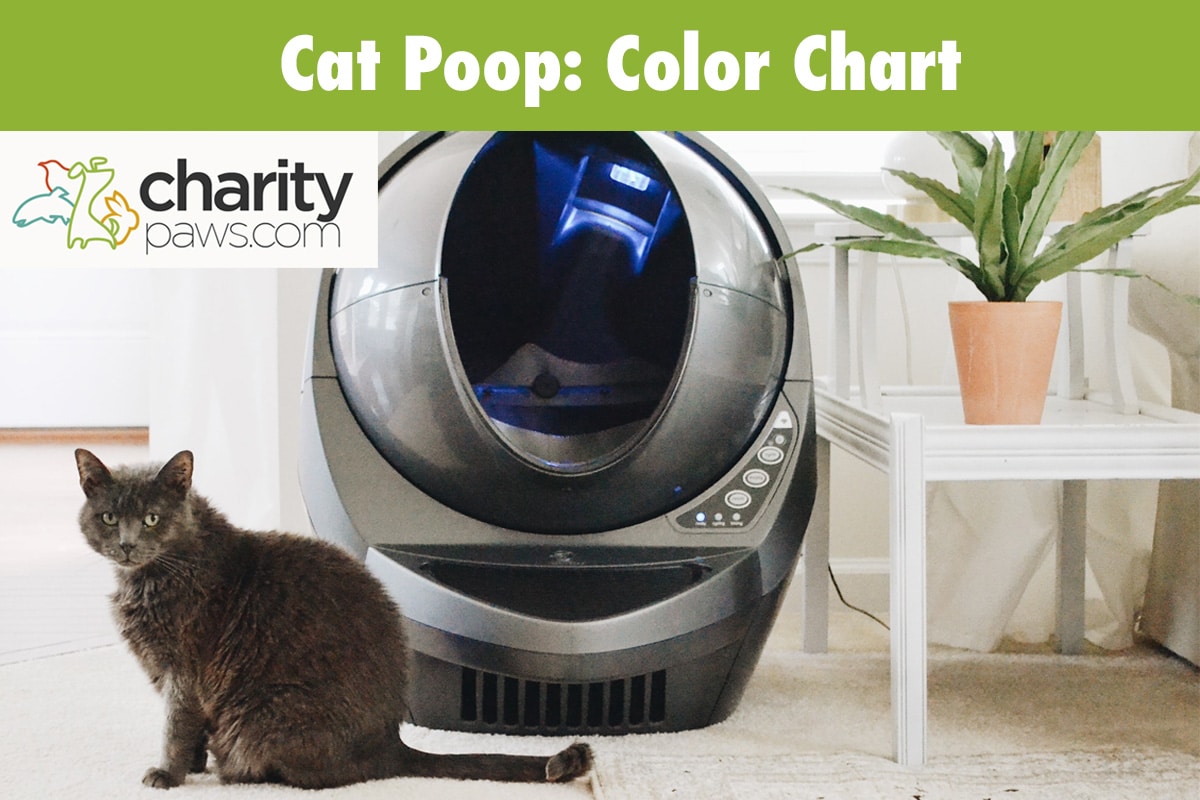Is your cat’s poop an unusual color?
If so, you are probably wondering what the cause of this might be.
In this article, we are going to explore cat poop color in more detail, looking at both normal and abnormal stools as well as what you should do to help your pet if things are not right.
What Should Healthy Cat Stool Look Like?
Before we look at abnormal poop, it’s important to know what normal cat poop looks like.
Healthy cats should be producing feces that are a uniform color, usually dark brown, but the shade can vary.
There should be no excessive mucus or blood present.
Normal cat poop should be firm and have a defined shape, with some visible cracks in it.
This should make it easy to scoop up or clean out a kitty litter tray with little or no residue left behind.
This type of feces would be graded a 2.5 out of 5 on a stool chart or fecal scoring system.
On a stool chart, a grade 1 poop would be very dry, hard, and crumbly, indicating constipation, and a 5 would be a liquid puddle that is seen with diarrhea.
Still not sure whether your cat’s poop is healthy? Our next section covers abnormal stools.

What Does Unhealthy Cat Stool Look Like?
There are two main categories of poop problems in cats – constipation or diarrhea.
If your cat has a problem with passing stools then they have constipation, but if they are passing stools too often then they have diarrhea.
That is a fairly simplistic overview, so we will explore each in more detail.
Constipation
Cats with constipation have difficulty in passing stools or are unable to produce them altogether.
Your cat may pass small, hard nuggets and spend more time straining in his litter box.
There can be a variety of causes of constipation including:
- Dehydration – lack of fluid leads to dry, hard stools (could be secondary to kidney disease)
- Lack of exercise – being too sedentary
- Impaction – usually with ingested hair (often seen in long haired-cats), or through eating a foreign body
- Tumors or growths – causing an obstruction, making passing stools tricky
- A nerve disorder – affecting the muscles that control the passage of stools
- Trauma to the pelvis – injuries may cause a narrowing in this area
- Hernia – a weakness in the muscle that could cause issues with stool transit
You should always get your cat checked out by a vet if they are constipated, rather than trying to treat things yourself.
Constipation in cats can indicate an underlying health complaint.
Diarrhea
A common problem in cats is diarrhea, which may vary from a slight loss of shape through to liquid puddles.
Loose stools are an obvious indicator that there is a problem with your cat’s digestion, especially if they are going to the bathroom more frequently or if there is a sudden color change.
There are many reasons why your cat might have diarrhea, which include:
- A sudden change in diet – a sudden change of diet type or brand could affect your cat’s stomach
- Dietary indiscretion – eating something he shouldn’t have done like food that has gone bad
- Infectious diseases – such as viruses, bacterial infections, and parasites
- Inflammatory bowel disease – (IBD) inflammation in the digestive tract
- Pancreatitis – inflammation of a small organ called the pancreas could lead to diarrhea
- Underlying health issues – thyroid problems or cancer could cause loose stools
If your cat is experiencing a mild bout of tummy upset but is otherwise well, then you could try some bland food for a few days.
Bland food is cooked chicken, white fish, or a prescription sensitivity diet.
Probiotic supplements can also be helpful to get things back on track.
However, if things are not resolving or if your cat has other symptoms like vomiting, inappetence, lethargy, or blood in his stools then a trip to the vet is warranted.
Young kittens go downhill quite quickly so make sure you seek help sooner rather than later for them.
With diarrhea particularly, you may sometimes notice a change in the color of your cat’s stools.
Let’s explore this further and see if the color of your cat’s poop determines what the underlying cause of their problem is.
Cat Poop Color Guide
Sometimes your cat may produce stools that are an unusual color.
Let’s look at what each of these colors might mean regarding their health.
Brown Color
This is considered the normal color for cat feces.
Different shades are possible though from dark brown to a more light color, depending on your cat’s diet and hydration status.
Black Color
Very dark or black stools could indicate digested blood in the feces.
This is known as melena which may also cause the poop to be sticky and tar-like in appearance.
A serious bleed in the upper digestive tract from a tumor, ulcer, or a clotting disorder issue could cause this.
Grey Color
Grey cat feces may be seen if your pet has an issue with the digestion of fats, usually caused by a problem with the liver or pancreas.
Stools may also appear grey if there is a large amount of jelly-like mucus present.
Tan or Beige Color
Beige cat poop or tan cat poop could be a variation on normal, with lighter-colored stools sometimes seen with changes in diet (especially those higher in fiber).
However pale poop could also be an indicator of an underlying liver problem or an issue with the pancreas, affecting the digestion of fats.
Red Color
Fresh blood in your cat’s feces may appear like red streaks, droplets, or generalized bloody stools.
This usually indicates a bleed in the lower digestive tract which may be due to a variety of conditions including parasites, infection, constipation, or inflammatory bowel disease.
Be aware of your cat’s food color as well. While most cat food tends to be brown or yellowish in color, some kibble can have a red tone.
Yellow or Green Color
Green or yellow cat poop colors can be seen in feces that have passed too quickly through the digestive tract.
Sometimes liver or pancreas conditions can contribute to color changes in stools.
White Color
White cat poop is not typically seen; however, you may notice white specks.
This could indicate parasites, with tapeworm segments often appearing like this.
When Should I Be Concerned About My Cat’s Poo Color?
It’s important not to ignore any problems with your cat’s stools, as these are a good indicator of his overall health.
Most vets, however, are less concerned with the exact color of your cat’s stools than they are about the consistency and appearance.
The exception to this is red or black stools which indicate bleeding, so it is very important to tell them if you have noticed this and get your pet seen as soon as possible.
If your cat’s poop are very hard and dry, then you should also get them checked over.
Constipated cats can be very uncomfortable so if they have been unable to pass poop for a day or two then get them examined.
Mild self-limiting cases of diarrhea are common though but if your cat’s symptoms persist beyond a couple of days then you should seek help from your vet.
If your cat is showing other signs of ill health alongside changes to their stools, then you should get them a vet appointment.
This is especially important if they are vomiting, not eating, or seem lethargic.
What Will My Vet Do?
Your vet will start by examining your cat, looking at their hydration status, checking for any abdominal pain, and recording their temperature.
If your cat is otherwise well your vet may suggest some symptomatic treatment like a change in diet or a course of probiotics.
However, if they are concerned about your cat then they may recommend further tests.
Fecal samples can be helpful to screen for bacterial infections and parasites.
Blood tests are recommended if there is a suspicion of an organ problem like liver disease or pancreatitis.
It is sometimes necessary to perform diagnostic imaging like X-rays or ultrasound scans to look for foreign bodies, tumors, or markers of inflammatory bowel conditions.
Endoscopy and tissue samples of the intestines can also be useful if your vet is trying to diagnose some of these problems.
If your cat is very unwell then your vet may decide to keep them in for intravenous fluids, supportive treatment, and monitoring.
Your vet will guide you through the best course of action for your cat.
Final Thoughts On Your Cat’s Poop Color

Hopefully, you are now a bit clearer about what is normal and what is not when it comes to cat poop.
While many cats can suffer from the odd bout of loose stools, you must always contact your vet if you see fresh red blood in the feces or black discoloration, as these could indicate a serious underlying issue.
Equally get your cat examined if they are off-color, vomiting or if they have lost their appetite.
Most problems do better with prompt treatment, so always get your pet seen sooner rather than later if you are worried about them.
FAQs
What Should Cat Poop Look Like?
Normal cat poop should be chocolate brown in color, though the exact shade can vary.
Your cats’ stools should also be a uniform shape, firm, and leave little to no residue when picked up.
What Does It Mean If My Cat’s Poop Is Full Of Hair?
When cats groom they can accidentally ingest hair, which can sometimes pass relatively unchanged in their feces.
On occasion, the hair is vomited back up in the form of a hairball, or more rarely an obstruction can occur in your cat’s digestive tract causing serious problems.
Is It Normal For Cat Stools To Be Light Brown?
The exact shade of brown that your cat’s feces are may depend on their diet.
Most vets would not be concerned by a lighter shade, as long as the consistency or texture of your pet’s stools is normal.
If your pet seems unwell, however, or you are noticing loose stools, blood or mucus then get them checked out.

